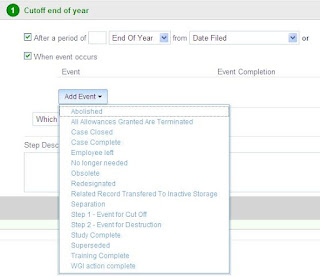We have a habit in the industry to create complex scheduling rules and I am eager to find out if Alfresco can handle them. There is a trend in the industry, by the way, to simplify scheduling rules so that systems can interpret our instructions.
I like the way Alfresco has interpreted the complex world of scheduling.
- Cut-off is what starts every scheduling event. The concept of cut-off is part of the DOD standard.
- The cut-off date is the signal for the system to begin counting down the retention of the record.
- Automatic cut-off is date based; either monthly, qarterly, by year or fiscal year.
- Event based cut-off requires manual intervention. Several events are built in to Alfresco and include all on the screen print below.
- Multiple events can be added to a single file, and I can also set if all events must occur, or the earliest event to start cut-off.
- After the cut-off is set, any number of intermediate steps can be added. For instance, transfer of paper records to a semi-active facility. Similarly in an electronic world, it could be possible to schedule archiving steps. ( I can't test how Alfresco handles content in multiple repositories).
- I added a series/category/folder
- I managed the permissions for all three to include my user ID.
- I added scheduling steps, cut-off at the end of the year from publication date, then immediately destroy.
- I then uploaded content, added the mandatory metadata for a few files, then declared the records, all with retroactive publication dates of December 14, 2010.
- When I took care that I had viewing rights, the declared record did not disappear as before. Success!
- I was expecting with a retroactive publication date for all contents the folder would update, showing it was ready for cut-off immediately. It did not.
- I was able, however, to manually "Edit Disposition Date". This I did.
After editing the disposition date, I was able to cut-off the folder and then "destroy" it, as tested yesterday. Again, I was given two warning messages before destroy. The icon for the folder changed, and the content is gone.
I rate this test a PASS
Records Manager
- Note that all subesquent steps are calculated from the cut-off date. If you are used to a schedule that says for instance, "Onsite for two years, then five years onsite, Destroy", the steps could be recorded as "1. Cutoff end of calendar year, 2. 2 years from cutoff, offsite, 3. 7 years from cutoff, destroy."
- Alfresco appears able to handle complex scheduling requirements, multiple events, multiple steps.
- As noted yesterday, if scheduling steps are working well, they should be fairly invisible to the regular user.
- You would become aware of the scheduling rules if you request a file that has been destroyed. Your best assurance at that time would be to review the schedule and confirm that the record was destroyed on time, as authorized.
- If you are ever asked for input on cut-off requirements, avoid event driven cut-off as much as possible, as they nearly all require manual intervention. Manual intervention equates to time-intensive management. Imagine receiving quarterly or annually a list of your folders, asking which can now be closed, or cut-off?
Developer
In an effort to simplify disposition actions, future schedule instructions may calculate retentkion from creation or "last modified" date. These may need to be added as cut-off conditions.
Notes
Testing DOD 5015.2 Features C2.2.2.7, C2.2.7.1.4, relating to GARP principle of Retention.



